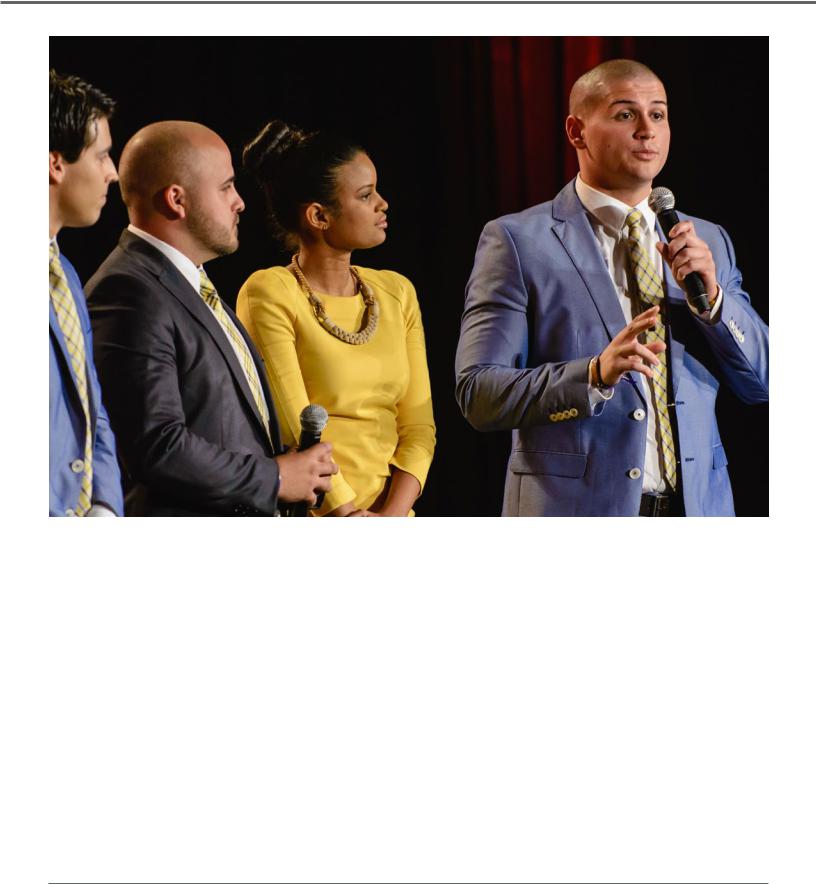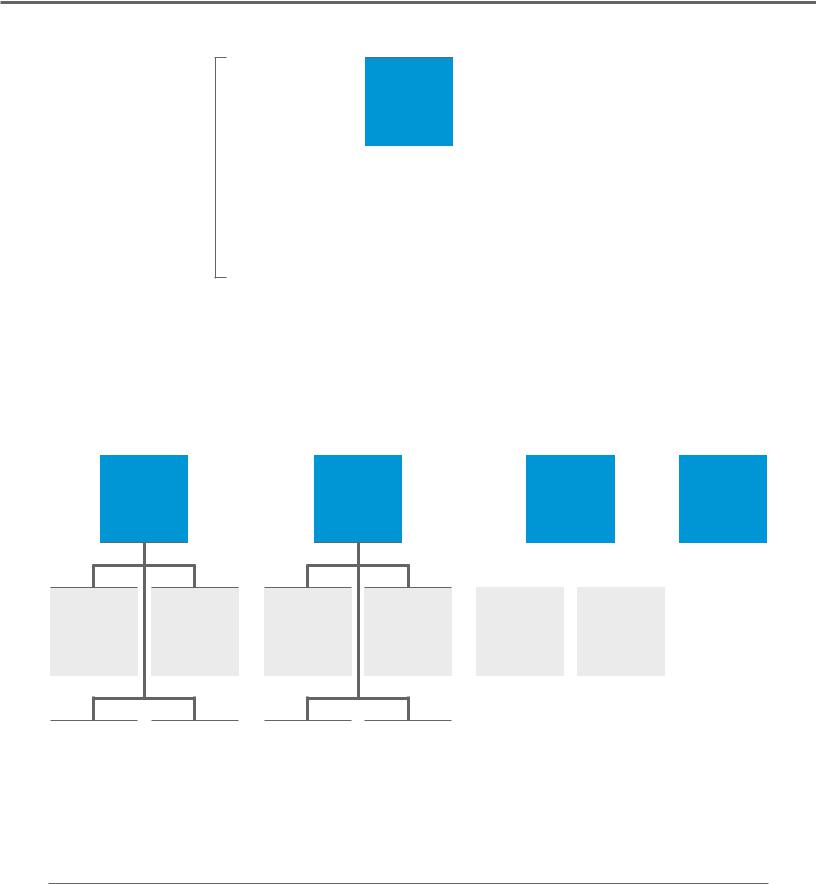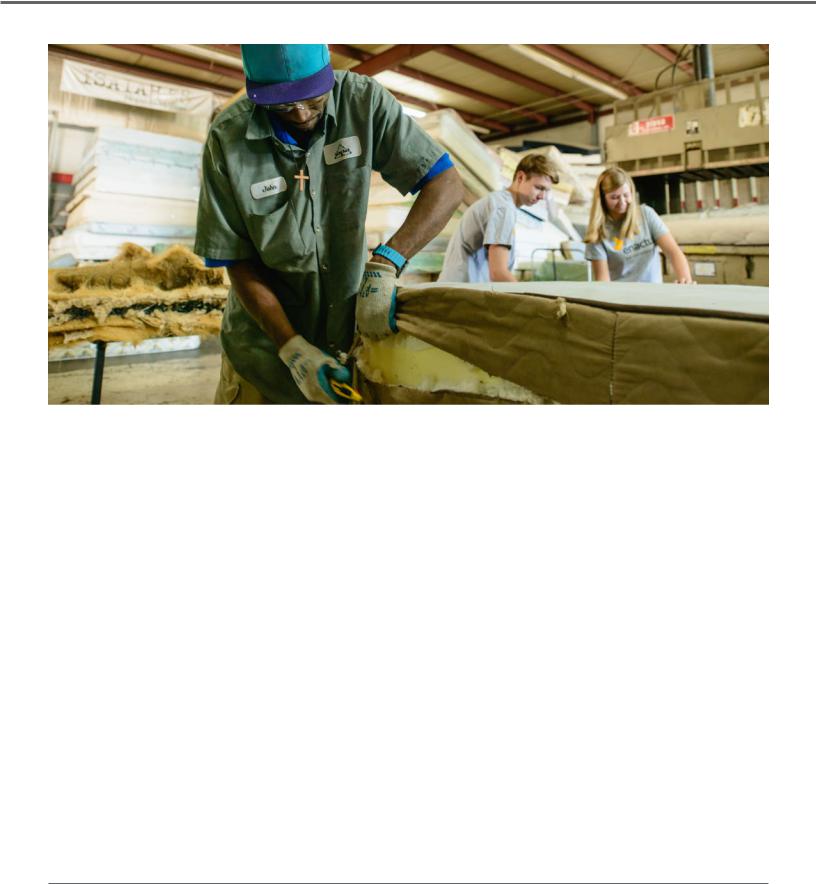
2014-15 Enactus Team Handbook
.pdf
DEVELOPING A MISSION STATEMENT, GOALS AND OBJECTIVES
The Drucker Foundation for Non-Profit Management defines a mission as “Why you do what you do; the organization’s reason for being; its purpose.”
Given the flexibility each university has to implement Enactus, developing a mission statement is an important step new teams should consider. For veteran teams, this exercise will energize and refocus efforts. A mission statement is not a slogan! Written correctly, your mission should provide a perspective for making important decisions, such as what community outreach projects to develop, which audiences to target, what outcomes you hope to achieve through the projects you implement, and members of the community you should involve as partners in your projects. Developing a mission statement is the first step in establishing your team identity and should be the primary means by which you communicate your team’s purpose and inspire commitments from internal and external constituents.
Given the unique nature of each college or university, try to develop your team’s mission statement in a manner consistent with the values reflected in your own institution’s mission.
Enactus Purpose:
To enable progress through entrepreneurial action.
Sample Team Mission Statements:
•To empower members of our community to improve their livelihoods through entrepreneurial action.
•To implement projects that will empower our community with business and entrepreneurial skills resulting in better and more sustainable sources of livelihood.
•To better the lives of people in our community by empowering them through entrepreneurial action to obtain better and more sustainable sources of livelihoods.
Key Ideas
•Look at mission statement examples from successful organizations around the world
•Work within the broad framework of Enactus and your college/university
•Keep the language simple
•Write a mission statement that clearly defines why your team exists
•Reflect on your mission statement as you make project decisions
Enactus Team Handbook • Academic Year Ending 2015 » 21

STUDENT RECRUITMENT AND TEAM ORGANIZATION
Enactus is a community of people who have committed to making human progress our business. When more students participate on an Enactus team, more transformational experiences will be created and more lives will be changed.
Participation in Enactus is not limited to students in business studies. You should make an effort to recruit members from outside the business school. These members will bring a fresh perspective and valuable skill sets to the team.
Academic institutions are dynamic environments. Every year, valuable Enactus students graduate while other students begin their journey
through higher education. This constant turnover means that recruiting new members is a never-ending necessity that requires constant attention. Your strategy should entail of actions to take throughout your program year to add new students.
To help with your student recruitment, Enactus World Headquarters launched a global campaign that you can implement on your campus. Visit enactus.org/seeopportunity/take-action/on-your-campus to learn more about the campaign and download recruitment materials and resources.
22 ‹ Enactus Team Handbook • Academic Year Ending 2015

BUILDING A SUSTAINABLE TEAM & PROGRAM
Institutional Support
Institution
Administration
(President,
Provost, Division,
Dept. Chairs)
|
|
|
|
|
|
|
|
|
|
|
|
|
|
|
|
|
|
|
|
|
|
|
|
|
|
|
|
|
|
|
|
|
|
|
|
|
|
|
|
|
|
Student Career |
|
|
Faculty |
|
|
Student |
|
|
|||||||||
|
|
|
|
Advisor |
|
|
|
|
|||||||||||
|
|
Services and/or |
|
|
|
|
Leadership & |
|
|
||||||||||
|
|
|
|
(appointed by a |
|
|
|
|
|||||||||||
|
|
relevant |
|
|
|
|
Development or |
|
|
||||||||||
|
|
|
|
university |
|
|
|
|
|||||||||||
|
|
department |
|
|
|
|
Student A airs |
|
|
||||||||||
|
|
|
|
administrator) |
|
|
|
|
|||||||||||
|
|
|
|
|
|
|
|
|
|
|
|
|
|
|
|
||||
|
|
|
|
|
|
|
|
|
|
|
|
|
|
|
|
|
|
|
|
|
|
|
|
|
|
|
|
|
|
|
|
|
|
|
|
|
|
|
|
|
|
|
|
|
|
|
|
|
|
|
|
|
|
|
|
|
|
|
|
|
|
|
Team |
|
President/CEO |
|
Business |
|
|
Team |
|
|
|
|
||
|
|
|
Executive Board |
|
|
|
|
|
|
|
|
|||||
|
|
|
|
|
Advisory Board |
|
|
Alumni |
|
|
|
|
||||
|
|
|
or Committee |
|
|
|
|
|
|
|
|
|
|
|||
|
|
|
|
|
|
|
|
|
|
|
|
|
|
|
|
|
|
|
|
|
|
|
|
|
|
|
|
|
|
|
|
|
|
|
|
|
|
|
|
|
|
|
|
|
|
|
|
|
|
|
|
|
|
|
|
|
|
|
|
|
|
|
|
|
|
|
|
VP of Projects |
VP of |
|
VP of |
VP of |
|||||||
Administration |
|
||||||||||
|
Marketing |
Recruitment |
|||||||||
|
& Finance |
|
|||||||||
|
|
|
|
|
|
|
|
|
|
||
|
|
|
|
|
|
|
|
|
|
|
|
|
|
|
|
|
|
|
|
|
|
|
|
|
|
|
|
|
|
|
|
|
|
|
|
Project |
|
Project |
|
Treasurer |
|
Fundraisers |
|
Media |
|
Annual Report |
|
|
|
|
|
& Presentation |
|||||
Leader 1 |
|
Leader 2 |
|
|
|
Relations |
|
|||
|
|
|
|
|
|
|
Coordinator |
|||
|
|
|
|
|
|
|
|
|
|
|
|
|
|
|
|
|
|
|
|
|
|
|
|
|
|
|
|
|
This sample organization chart considers various roles |
Project |
|
Other Project |
|
Team |
|
Secretary |
and ideas. Each team must design an organization that |
|
Leaders as |
|
Historian/ |
|
works. Institutional support should include guidance, |
||
Leader 3 |
|
|
|
||||
|
needed |
|
Sustainability |
|
|
||
|
|
|
|
|
mentorship, motivation and support for a fully functioning |
||
|
|
|
|
|
|
|
|
|
|
|
|
|
|
|
and successful program and team. |
Enactus Team Handbook • Academic Year Ending 2015 » 23

INSTITUTIONAL SUPPORT
Having the support of your institution and administration is crucial to the success of your team. Administrators control university resources and determine how they are specifically allocated. Obtaining institutional and administration support can increase your team’s likelihood of receiving resources.
Remember that funding is not the only support your institution and administration can provide. There are many opportunities for your institution and administration to support your team by allocating resources such as:
•Personal time
•Printing and material resources
•Access to university and community networks
•Funding for projects, travel and/or team activities
•Office space for the team
•Course releases for faculty to serve as advisors
•Course credit
Keep in mind that resources are limited for every university. Never assume the above resources are available for your team. The only way to truly know is to ask.
Obtaining Support
Institutional support is most easily obtained by building personal relationships with administrators. It is important to identify the influential individuals at your institution who have the ability to allocate resources to your team.
Developing a pitch specifically for administrators is vital to gaining their support. First, find out what your team can do for the institution and administration. Pitch your team as a solution to
a problem they are facing and clearly state what is in it for them. Identify current or future activities that parallel the administration’s objectives.
Be proactive in developing a relationship by getting
them actively engaged. For example, ask your administrators to:
•Serve on your Business Advisory Board
•Attend team meetings
•Participate in projects
•Critique your team’s presentation prior to competition
•Attend official Enactus events, such as team training conferences and competitions
Administrators who are actively engaged with your team are much more likely to see the benefits your team brings to the institution.
Reminder: It is a requirement that all competing teams have their Annual Reports reviewed by an institutional administrator and obtain his/her signature on the Project Verification Form as acknowledgement and endorsement of the institution’s Enactus program.
Key Ideas
•Determine how your team can benefit your institution and administration
•Create a pitch that clearly explains what’s in it for them
•Keep administrators informed about what’s important to them
•Engage administrators in team meetings, projects and events
•Remember an administrator must sign your team’s Project Verification Form
•Utilize the Institutional Support Best Practices Guide
24 ‹ Enactus Team Handbook • Academic Year Ending 2015

FUNDING
One of the traits that sets Enactus apart from many other organizations is that Enactus does not charge students or teams for their involvement in the organization. It is very likely, however, that your team will have a need to seek funding sources throughout the year to accomplish your goals and objectives. Since most teams are self-supporting, the necessity for fundraising often falls upon the shoulders of the team members. The decision to conduct entrepreneurial activities or solicit donations should be driven
by the need to finance your team’s outreach efforts and operational expenses.
To help you with your fundraising goals, we have identified several approaches that have been successful for you to consider pursuing:
1.Institution
•Most student government associations save a block of funds to allocate to student groups for travel or team projects. Pursue this avenue when you register your team as an official organization at your institution. Keep in mind that it is better to have these requests filed early in the academic year as funds are limited.
•Discuss with your dean, department chair or president the opportunity for your team to receive seed money at the beginning of each year. This approach is often bolstered by effectively utilizing media (the next section of this book) as it strengthens your standing to be able to say that your team is providing a positive reflection within the community.
2.Civic Organizations/Foundations
•To access these groups you might start by asking around your institution to find out which staff members, professors and/or administrators are members of different civic groups. They can take you as a guest to their meetings and help you navigate the funding options.
•There are countless foundations that offer funding options. Almost every corporation has its own foundation that makes charitable contributions. Although it may be difficult to secure funding from a large corporation, companies or organizations within your own community, such as a local bank, may be realistic sources for securing grants.
•Should you decide to pursue grants as a source of funding, it is important for your team to realize that this is often a slow process and you should be diligent in your approach. Seeking funding at multiple dollar amounts from different foundations often makes it more likely that you will obtain one or more grants. It is often most effective for your team to develop a
project concept with specific measurable outcomes that you plan to present for grant funding. Don’t be afraid to use an idea as a template that you submit to multiple foundations in hopes that one will respond.
•Foundation funding is often a one-time source of support – many foundations do not give annual gifts. Therefore, if you wish to receive a multi-year gift it is important to submit a project opportunity which spans over the course of multiple years with annually measurable outcomes that culminate to a net positive effect over time. (i.e., working with one group of younger students starting when they are first year and
seeing them through to graduation; or working with a group of government support recipients to see them through a process of attaining financial independence by attaining a job, utilizing a budget and eventually planning for their future.)
3.Entrepreneurial Operations
•Your institution provides an immediate customer base for small entrepreneurial operations, such as leasing vending machines, setting up a small coffee stand/shop, or selling concessions at athletic or other social events. Make sure you gain approval from your institutional administration before setting up shop.
•Many times an institution, depending on size, will sign an exclusive operations contract with a particular company (such as the one who runs your cafeteria). If this is the case, you might consider approaching the facility manager about a partnership whereby if they will let you operate such enterprises you agree to purchase merchandise through them.
4.Project Partnerships/Special Competitions
•Check with your Enactus country office to see what opportunities may be available.
Enactus Team Handbook • Academic Year Ending 2015 » 25

MEDIA
Every year, Enactus teams make headlines in thousands of local, regional and national media outlets. Working with your local media is an excellent way to receive recognition and increase support for your team’s activities. Here are some tips for publicizing your efforts to the mass media:
•Study your local media market. Identify what specific stations, papers, etc. serve your local community. Pay particular attention to the reporters most likely to cover stories about your team’s activity.
•It is important to use an up-to-date contact list. Take the time to contact your local media outlets, introduce your team and collect their contact information. For each outlet, make sure you collect the contact information for any specific reporters you identified in the previous step as well as the assignment manager.
•As in any other industry, working with the media has a lot to do with relationships. Personally introduce yourself to local reporters and contact them throughout the year with story ideas.
•Whenever applicable, use the custom press release templates provided by Enactus.
•Solicit advice and assistance with your media efforts from your college or university’s public relations office.
•Before sending a press release to your local media, contact the assignment manager at each outlet to determine how they prefer to receive the information, e.g., mail, fax, e-mail, etc.
•Your first press release for a project should be
sent approximately two weeks in advance of the actual event.
•Send a brief media alert approximately two days before the date of the project or event. This should simply be a brief reminder with a few key sentences summarizing the activity.
•Make a final phone call to the assignment manager early on the day of the project or event.
•Most newspapers and radio stations have calendar information sections. Send a brief paragraph about an upcoming event to be included in these sections.
•Check with the specific media outlet to determine the leadtime required. It might need to be several weeks in advance.
•Most network television affiliates produce a local daily morning news show. These programs usually contain a significant block of time reserved for community guests. Try to arrange for a representative to fill one of these guest spots. Identify and contact the producers of these shows to schedule an appearance.
•Post videos of your projects online for use in web-based reporting.
•Provide the media with links to your team’s website and social media pages for more information.
Presenting Your Stories to the Media
The elements that make your team’s projects so successful are the same as the elements that make them so interesting to the media:
•Develop media pitches focused on the people helped by your team’s efforts.
•Describe the problem and express your team as the solution.
26 ‹ Enactus Team Handbook • Academic Year Ending 2015

TEAM PROJECT PHOTOS
Share Your Project Stories and Photos with Enactus World Headquarters
Nothing tells the story of Enactus better than seeing the entrepreneurial spirit in action!
Share your project photos with Enactus World Headquarters, and you may see your photo on the cover of the next Team Handbook, on enactus.org, or in a video at World Cup. Here’s the type of photo that works best.
•Show action! Rather than posed photographs, capture the essence of your project through the action it creates.
•Include team members and beneficiaries. It’s powerful to see Enactus students interacting with the communities we serve.
•The higher the resolution the better. Today’s smartphones are capable of 8 megapixel photos or more. If you have access to a digital SLR camera, these will yield the best project photos.
To get even better project photos, consider partnering with your University’s photography department. Have a photography student accompany your team on your next project outing.
To submit your photos, email them to trowett@enactus.org. If you have video, send it our way as well! Be sure to include a brief description of the project and a contact name and email address in the event we have questions.
By submitting your photo, you are granting permission to Enactus and its agents, employees and affiliated organizations to use the photograph in Enactus publications such as recruiting brochures, newsletters, and magazines, and to use electronic versions on web sites or other electronic form or media, and to offer them for use or distribution in other non-Enactus publications, electronic or otherwise, without notifying you. You waive any right to inspect or approve the finished photographs or printed or electronic matter that may be used in conjunction with them now or in the future, whether that use is known or unknown, and you waive any right to
royalties or other compensation arising from or related to the use of the photographs.
Enactus Team Handbook • Academic Year Ending 2015 » 27

TEAM SUCCESSION PLANNING
Each year team membership numbers tend to fluctuate because of member graduation and recruitment efforts. To ensure a quick and efficient start to the academic year, teams should create a team succession plan. The object of the plan is to ensure that the students who will be returning next year understand the team’s goals, objectives and methods well enough to continue the team’s momentum.
Some of the key ideas of the plan include:
•Determining next year’s leaders early enough that they may be properly trained by the current leaders.
•Creating a shadowing or mentorship program for members who would like to be in a leadership role.
•Recruiting younger members (first-year and second-year students). This strategy can add stability to team membership.
•Creating a yearly transition notebook.
Yearly Transition Notebook
One of the most important tools your team can create for sustainability is the yearly transition notebook. Think of this document as a blueprint for your team. If someone who knew nothing about your team picked up this document, they should be able to immediately understand what your team is about.
Below are some of the items the notebook should contain:
1.Team organizational chart
2.Tentative calendar of events
3.Full summaries of ongoing projects
4.Copy of most recent annual report and competition presentation
5.Tentative dates and deadlines for items due to your Enactus Country Office
6.Contact information for the entire team and all groups associated with the team (BAB members, important institutional contacts, funding contacts, Enactus Program staff contact information, etc.)
7.All team financial documents
8.Team guidelines and bylaws, if applicable
This notebook should be updated at the end of each academic year, preferably at the year-end meeting of the team leaders. It should remain in the team office, with the Faculty Advisor or with the incoming team leader or president. The notebook will become
particularly important if your Faculty Advisor does not return or if the majority of your team graduates. In this situation the following items become essential to the continuation of your team:
1.Names and contact information for team supporters within the college/university.
2.All information associated with the team’s financial support (money that must be requested from the college/university, team donors, all fundraising projects, etc.).
3.Business Advisory Board contact information.
Your Country Leader or Program Manager should be available to assist you with this transition.
28 ‹ Enactus Team Handbook • Academic Year Ending 2015

TEAM AUDIT
Enactus employs a global auditing initiative for national champion teams competing at the Enactus World Cup. This initiative is viewed as an integral part of the program and is implemented by the Enactus Country Office. There are three key elements of this mandatory audit process: Team Engagement, Team Operational Review and Project Audit/Site Visits. Audit Preparation Tips can be found in this section of the Team Handbook.
Above and beyond the audit employed by Enactus and its local offices, all teams are encouraged to conduct self-audits either through internal evaluation or third-party review. Internal evaluation can be completed by team members in order to assess the team’s operational and programmatic activities. This type of evaluation can match the team’s performance against its mission, vision, goals and capacity versus achievements. The internal audit is an effective avenue for evaluating team functionality and increasing program impact. A self-audit completed by a third party means the team
has appointed an external auditing firm to conduct an audit. If a third party is appointed, then the team should be sure to share the results of the audit with the Enactus Country Office, especially if the team is selected as the National Champion. Again, the self-audit is not currently mandated by Enactus; rather, it simply provides the opportunity for a team to complete self-evaluation and increase credibility with future team recruits, institutional administrators, faculty and staff and community members.
In the event that your team is elected for an audit by the Enactus Country Office, you will be notified in advance and a timeline will be set on how/when the audit will take place. Although we have no doubt in the ethical practices of our teams, please note that we take this process very seriously and will take action accordingly if/when a team fails the audit. More information on penalties can be made available by your Country Leader or Program Manager.
Key Ideas
•Self-Auditing is an on-going process! As an Enactus team, this should be a natural phase of all your programmatic and operational activities.
•Do not wait until the end of the program year to audit yourself or prepare for the audit by your Enactus Country Office! Create an actual Audit Strategy.
•Take proactive measures in documenting your processes, systems, outcomes, etc. Consider appointing a member of your team with the task of managing all auditing procedures or request that a faculty person at your institution (preferably with auditing/accounting background) review your processes and lend advice
on how to best prepare. You may also reach out to an external source in advance and ask for their expertise on how to best manage your self-audit.
•Inform your project beneficiaries (well in advance) that they may be subject to interview by the audit
committee. This will avoid any challenges later when the audit is being implemented.
Enactus Team Handbook • Academic Year Ending 2015 » 29

TEAM AUDIT
Audit Preparation Tips for Teams
Should your team be selected to participate in an audit by the Enactus Country Office, it is essential that you are fully prepared. Below are some tips to assist you in preparing for such an initiative.
•Plan to have a conversation with the Enactus Country Staff in advance of the audit’s launch – this will ensure that
everyone is on the same page and expectations related to time commitment and preparation are realistic and aligned
•Have the following documents readily available for all phases of the audit:
°Team’s financial records
°Active Team Sheet/Roster for current year
°Team Data Sheet for current year
°Team Bio
°Annual Report used at the national competition [and/or to be used at the Enactus World Cup]
°Audiovisual Presentation (PPT) used at the national competition [and to be used at the Enactus World Cup]
°Project /Action Plan documents, including any agreements with beneficiaries
°Other project tracking and evaluation tools
°Other team organizational tools (hierarchy chart, tracking tool for hours invested, etc.)
•Have appropriate people available (e.g., Faculty Advisor, Team Leader, Project Leaders, etc.)
•Be prepared to:
°Explain any element of your team’s operation and details of the projects, especially those reported in your annual report and via presentation at the competition
°Explain the operation of your project plan (relevance, need, how target audience was chosen, showcase evaluation tools, frequency and mode of communication; in-person versus virtual/email/phone trainings, etc.).
°Provide all applicable documentation that may support your project outcomes.
°Identify project plan errors (shortfalls) and/or new opportunities, including future plans.
°Explain internal administrative processes (practices and procedures, etc.)
•Remember that the Enactus Country Office Staff are leading an important initiative and relying on you to be professional, courteous, and collaborative in your approach. Have a positive mindset and attitude – it will ensure that the process is much smoother and hopefully, a fulfilling learning experience for all.
30 ‹ Enactus Team Handbook • Academic Year Ending 2015
